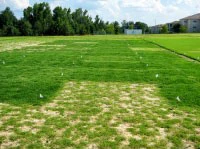
 Maybe last year’s program was perfect but this year’s conditions were different, or maybe last year’s program was a total disaster and you need a new plan. Whatever the case, deciding how to fertilize your turf going into the off season plays a large role in maintaining your course for next year.
Maybe last year’s program was perfect but this year’s conditions were different, or maybe last year’s program was a total disaster and you need a new plan. Whatever the case, deciding how to fertilize your turf going into the off season plays a large role in maintaining your course for next year.
Most golf courses these days are using foliar products in at least some of their program, says Dr. Grady Miller, professor of crop science at NC State University.
“[They’re] going to use a soluble product for greens, where most attention is directed,” he says. “When you get into the tees and fairways, you still traditionally see more granular-based programs.”
When it comes to picking the fertilizer product that’s best for your course, Miller says there are some things to look at first.
“Look at your soil test. Have some knowledge of what your soil might be deficient in. You can replenish or provide whatever the turf grass is using or needing depending on what the soil can provide or can’t provide. Some people follow that up with tissue testing to see what the plant is taking up. That can be very useful for diagnostic purposes. Considering that, you’re going to look at various nutrients, various ratios of nutrients, and how you want those released.”
There are other important things to consider when deciding on your fertilization program, and to make the best decision you need to look at all of them.
Key points
|
“There are certainly a number of factors,” says Kevin Frank, associate professor and extension turf specialist at Michigan State University. “One has to be, obviously what your entire program is. How you set things up throughout the spring, summer and fall. You can always talk about cost, and that is a factor that certainly weighs in the industry today. Another thing you have to consider at some point is how many times you have to apply.”
How many times you apply depends on what type of fertilizer you’re looking for.
“Control released products are often soluble products that, because of some membrane or protectant, release that product over time,” says Miller. “Slow release is often more of a homogeneous product. It kind of wears it away or microbial activity breaking it down. Stabilized is typically in some respect kind of like a control release. You have some chemical mechanism. In essence it’s kind of a controlled release situation.”
“There are soluble products, and those are going to impart an immediate release to the crop,” says Elizabeth Guertal, alumni professor at Auburn University. “They’re going to go into a solution rapidly, and the nitrogen and ammonia that the turf needs is going to be there. Soluble materials can either be sprayed as foliars, as liquids or as granular. Then you have slow released materials, and typically they’re slow released by one of two ways. They’re either slow release because there’s been a physical coating placed around a soluble material, like sulfur coat uria, or resin coat or polymer coat urias. Those are very big in the turfs marketplace. Or they’re slow release because of a chemical reaction, and those are the uria formaldehyde, methalene urias… those are also very popular and widely used in the turf marketplace. [T]hen you’ve got, kind of what I call naturally slow release, which are the true organics, which also have to be broken down by microbial activity, and those would be things from sewage sludges or bio solids, or manures; all kinds of different materials like that. Then kind of the other grouping is the stabilized nitrogens, and that’s sort of a trademark name, but they’re not really sold as, nor can they be labeled as, slow release, but they have something in them to extend the longevity of a nitrogen response in the crop; so those are materials with either a nitrification inhibitor or an ammonia volatilization inhibitor, or they have both.”
Despite all of this, most people agree that the right fertilizer for your course really depends more on the superintendent’s personal preference.
“I personally think you can use all of them,” says Frank, “it just depends on how you build your program. If you’re going into looking at what should I do in the fall, a lot of that obviously depends on what you’ve done to this point as you get into September or October. What did you do in the summer?”
It also comes down to what you want to get out of your fertilizer, says Guertal.
“The first thing is to look at what time of year it is,” she says. “What do you want that fertilizer to do? Do you want it to create growth? Or are you looking for maintenance of the turf area?”
 Budget is a very important factor to consider, as well, she says.
Budget is a very important factor to consider, as well, she says.
“Soluble nitrogen sources per pound of nitrogen are often cheaper, but you have to consider that they may be too large,” she says. “They may not be what you want to create a long term greening response.”
“You can always talk about cost, and that is a factor that certainly weighs in, in the industry today,” says Frank. “Another thing you have to consider at some point is how many times you have to apply. The slow and controlled folks will say if you apply one time you save labor, fuel costs of driving around, etcetera. That’s something superintendents should consider. Do you want to frequently apply with a lower cost product or pay a little more and not apply as often?”
“The hardest [thing] is when you budget for a soluble program and the nitrogen doesn’t last as long as you thought it would,” Guertal adds, “and then you have to reapply.”
On the topic of budget, it’s important to develop your fertilizing program the same way you develop your course’s budget: with room for adjustments, Miller says.
“Truth be known, developing a fertilizer program is a lot like developing a budget,” he says. “You can make good plans but you’ll probably have to adjust it along the way. Fertilizer programs are a lot like that. You can put down on paper when you think you would fertilize and the amounts and products based on soil tests and your experience, but almost guaranteed along the way you’re going to have to make adjustments. [For example] the east coast this year has gotten so much rainfall; lots of adjustments. Things happen along the way so you can put down a plan, and I suggest everyone do plan their fertility program, but you’re going to be constantly tweaking them.”
And speaking of tweaking, what happens if you chose a fertilizer option, put it down on your turf, and then realize you made a mistake?
“You have the ability to make changes as it wears off,” says Miller. “You can make subtle changes. Once you put the fertilizer out, there’s not really a way to take it back up. If you put down too little you can add some. It’s just a matter of monitoring your plant.”
Something that plays a big role in learning to know how to fertilize your turf over time is location. Although the general consensus is that all fertilizer types can be used anywhere, it is important to take into consideration what kind of affect your layout and climate can have on the product.
“[A]s you move into different climates, some of the slow release products break down quicker, so you use them differently,” says Miller. “If you move further north you may not fertilize as late in the year.”
“We put [a controlled release product] out on a slope and we got some heavy rainfall and it actually moved the product down the slope and accumulated in an area,” says Miller, explaining why your course layout should also play a role in your fertilizer choice. “When you move them off site and they accumulate you have problems. Placement issues can come into play.”
Your location can also play another role; one you may not have given much thought to. Before you run to your distributor and pick out a type of fertilizer, it might be smart of you to check state legislation.
“There are 11 states that have some type of phosphorous rule,” says Guertal, “so now superintendents are having to make decisions with somebody else making some decisions already.”
The 11 states Guertal mentions are Illinois, Maine, Maryland, Michigan, Minnesota, New Jersey, New York, Vermont, Virginia, Washington, and Wisconsin. Make sure to check the legislation however, because some of the states, such as Illinois, have exemptions for golf courses.
At the end of the day, it is always important to remind yourself that fertilizing your turf is a learned skill that takes time.
“Most supers get a feel within a couple years of how their greens respond to fertilizers,” says Miller.
Watch it
Black Mesa Golf Club superintendent Pat Brockwell shares their fall fertilization strategy and why it plays an important role in the spring green-up. Enter the following url into your browser to watch it now.
Fall Fertilization aft Black Mesa Golf Club - youtu.be/odKamBd8RLQ
Katie Tuttle is GCI’s assistant editor.

Explore the September 2013 Issue
Check out more from this issue and find your next story to read.
Latest from Golf Course Industry
- Editor’s notebook: Green Start Academy 2024
- USGA focuses on inclusion, sustainability in 2024
- Greens with Envy 65: Carolina on our mind
- Five Iron Golf expands into Minnesota
- Global sports group 54 invests in Turfgrass
- Hawaii's Mauna Kea Golf Course announces reopening
- Georgia GCSA honors superintendent of the year
- Reel Turf Techs: Alex Tessman





